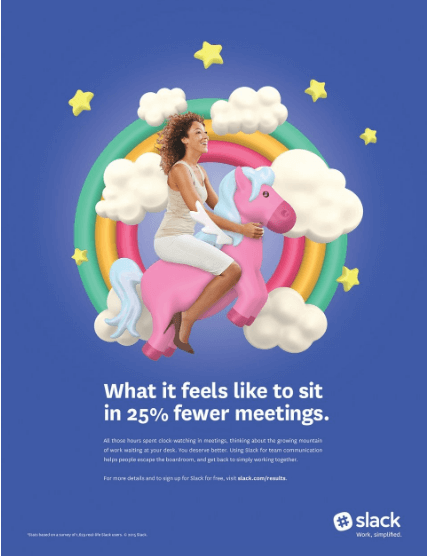Persuasive vs Informative Advertising: What’s the Difference?
Persuasive and informative advertising share the same goal — to persuade audiences to embrace certain attitudes and behaviors. This can be to stop drinking and driving, to vote for a certain politician, or to buy a specific product.
Informative and persuasive advertising use different approaches to achieve the same end goal. One appeals to emotion, while the other is about education. (Though even informative ads often have a little emotion thrown in).
Informative advertising sticks to facts. Persuasive advertising incorporates a broader range of methods to influence its audience. Both are important tools for convincing consumers to take action or change their behavior.
In an age where ads have become little more than white noise, standing out is marketers’ number one priority.. A blended technique can help you do that. Understanding the basics of both persuasive and informative advertising can help you determine how to make your messages and products memorable and desirable.
What is Persuasive Advertising?
Persuasive advertising aims to convince its audience of a certain belief that leads to action — often buying products. Persuasive advertising uses various techniques to appeal to the logical, emotional, and ethical sides of our decision-making process. Not all buyers are strictly rational in their purchasing decisions and not all buyers are purely emotional. There is room for both objective facts and creativity when it comes to influencing their beliefs, and ultimately, their behavior.
Persuasive advertising revolves around the idea that purchasing a product or service is not always a perfectly logical process. If customers always chose the best product for the job, advertising would be a very different world (and might not even exist). A classic example of this is the infamous “Power Glove”, which uses brilliant persuasive advertising for a terrible product. For this reason, organizations must walk the line between efficacy and ethics.
Both B2C and B2B companies use persuasive advertising techniques to appeal to the multifaceted nature of their audience.
Persuasive Advertising Techniques
Humans respond to many different methods of persuasion and advertisers have learned how to incorporate these techniques into their ad campaigns.
Reciprocity
When people receive something free from others, they feel indebted to them. They feel like they have to give something back. In the B2C space, this could look like discounts and rewards driving customer loyalty. Not only is there increased incentive to buy, but consumers feel like they have received something valuable—a token of brand goodwill—so they should spend some more money at the store.
When it comes to B2B software companies, many have poured their resources into content marketing. When websites offer valuable advice for free, readers feel a connection or loyalty to these websites. They feel like they can trust these vendors to be knowledgeable about a particular strategy or vertical, and they want to invest their money in a platform or service that’s going to be helpful and continue putting out strong industry guidance.
Content marketing does not only play into this idea of reciprocity. Content marketing allows companies to grow their reputation as respected authorities on certain topics (with readers, and with search engines!) Authority creates influence.
This kind of marketing is central to the inbound marketing philosophy, which stresses relationship building with customers. Organizations create free, genuinely helpful content to nurture a relationship with their customers. In time, customers feel a sense of loyalty and even attachment to the company. You can learn more about inbound marketing, and its inverse, outbound marketing, here.
Many people stick to a car brand they know and like, or have a favorite grocery store. You have almost certainly experienced this yourself. We humans bond with nearly anything. As an organization, if you can create this bond, you can create more reliable, repeat customers. These individuals can even be a great source of advertising material themselves. They can share their experience with your brand on social media, promote it within their own networks, and more.
Authority Figures and Influencers
People simply do not trust advertisers, marketers, or anyone selling anything. This is why advertisers need to partner with authority figures to convince buyers that the product is what it says it is. Authority figures can be highly educated professionals — doctors, lawyers, scientists and the like — or they can be celebrities and influencers.

For the general consumer population, celebrities are huge influencers when it comes to increasing the popularity of a product. Individuals look up to celebrities for their beauty, fame, fashion choices, and lifestyle. If individuals see their favorite star wearing a certain brand or aligning themselves with a certain product, they are more likely to embrace the brand as well.
It is important to remember that an authority figure works because of their relationship to the customer as well as the product. Many celebrities are in no way experts of what they advertise. Rather their effectiveness comes from a place of kinship that consumers feel with the celebrity. The goal is to have your customers think “I can be like them” when they see your ad.
Doctors and scientists have a form of this, because we all know what “a doctor” is. A perfect example of this at work is in non-FDA-approved supplement commercials. Adding a figure in a white lab coat, who for some reason has a stethoscope adds authority because we trust these figures. We have a willingness to accept information from “experts”.
In the B2B world, influencer marketing is a bit different. Like celebrities, influencers have leverage over the opinions of their engaged audiences. (And, like celebrities, it is often based on their ability to make money and achieve status). Unlike celebrities, business influencers have more of a niche following. They have gained respect for their success and innovation in a particular industry or department.
B2B influencers are perceived as more intentional when they advocate for a brand — typically, they or their clients have worked with this brand to achieve demonstrable business results. B2B influencers are perceived to share only brands that they actually believe in and have experience with, rather than being paid millions of dollars to take a picture with a water bottle. Rather than posing for something like an Instagram ad, B2B influencers may agree to speak on a panel at an event, or host a webinar, or write a post on LinkedIn.
This can stem from a different relationship with the customer. Companies are made up of people with different personalities, interests, and experiences. Shaq is not going to work to sell HR software, because not everyone in the company will always identify with him. As a result, you tend to end up with more genuine experts, staking their credentials on products.
Influencers are speaking to the professional side of people, their work personalities. This is the relationship that they are cultivating and works differently than that of B2C marketing. Whether people of influence gain their authority by training, popularity, or creating a social media following, they can all help brands build a connection with consumers.
Emotional Tactics
People are often motivated by pleasure or fear. If your product brings delight to consumers, advertisers can highlight this pleasure with upbeat, positive or sentimental ads.
Fear, on the other hand, highlights real risks and challenges that individuals face. Fear-based advertising can be used to invalidate competitors, dissuade viewers from bad habits, or to show consumers they need protection. Insurance or medical companies can strike fear in their target audience and show how their services protect customers from crisis. Organizations can also use things like cute animals to elicit an emotional response. This is a staple in relationship-building and tear-jerker commercials.

Both sides of the coin apply to B2B advertising as well. Though we may not feel as much of a personal connection to business products and services, our jobs—the people we work with, our day-to-day tasks, our work/life balance, our career paths, and the salaries we make—certainly strike an emotional chord. B2B advertisements may target business leaders with fear-based tactics about company success and failure, security breaches, etc. Or, they may target managers or individual contributors by promising to make their work easier and elevate their success to leaders.
These emotional plays should be used responsibly and with restraint. They should have a basis in a genuine feature of the product or service, rather than in fear-mongering or sensationalism. Advertisers have a duty to ensure their own ethical marketing practices.
Humor
Everybody loves to laugh. When an advertisement makes individuals laugh, it brings them joy. And joy is memorable. It’s also sharable! We’re much more likely to share a funny advertisement with friends, or seek it out to show them. Especially in a world where consumers are bombarded by advertisements at every turn, humor is a welcome break from the mundane.
More dangerous still, humor can be offensive. Some of the most effective advertisements in the world play with humor. Some of the worst come from poor attempts at humor. In your organization, make sure you cultivate an environment where humor can be openly and freely assessed. Even an intern should have the ability to say “that’s not funny”.
Organizations should have a diverse group of individuals looking over content, and be wary of any one person speaking for a community. In summary, use humor carefully, skillfully, and with plenty of review.
People Want to Join the Bandwagon
Most people follow crowds. This is why more people in a new area will choose an unknown restaurant that has a long line versus an unknown restaurant that has no current customers. Even though the line causes inconvenience, you know the food must be good — because that’s what everybody is eating. People trust brands that already have a large following.
Social proof is a good way to show potential customers that your brand is trusted and respected. Whether you’re in B2B or B2C advertising, gathering customer reviews and highlighting customer testimonials can be a good way to showcase how your product has impacted the lives of other customers. You can learn about social proof and its impact on brand performance here.
The Scarcity Principle
People love to have what others can’t have. Flash sales and limited offers can create urgency in shoppers. When items are limited in quantity or have a discounted price for a limited time, consumers feel the pressure to buy before missing out on the opportunity.
These types of deals enable shoppers to boast to their friends “I got the last one available” or “only the first twenty people got 50% off.” They can pride themself on their special deal. For many people, this feels like a rush and makes the shopping experience more exciting and rewarding.
In a B2B context, you can think of this as the desire to be innovative and get ahead of the curve. Companies want to have a competitive edge. They want to get there first. They also want to work with partners and vendors who are innovative, pushing for growth and change. Not everyone can have white-glove service, or help shape the future of their industry. Many businesses respond well to the idea that they are somehow elite, with an advantage over their competitors. Many B2B companies also offer discounts on hardware and software products to help sweeten the deal. This helps incentivize B2B buyers to move faster and decide to make the purchase.
Persuasive Advertising for B2B
We are used to seeing celebrities, humor, and emotional tugs in the B2C space, but what about the B2B world?
Even though business software advertisements tend to focus on features and use cases, creative B2B marketers are finding fun and innovative ways to capture audience attention and influence buyers just like their B2C counterparts.
1. HP’s secure printers as told by Christian Slater
HP crafted a short video featuring Christian Slater, called “The Wolf.” Using a unique storytelling method and a famous celebrity, HP challenged the notion that B2B companies need to keep advertising traditional and boring. This advertisement has amused more than 2 million viewers, while also calling to attention to the importance of printer security.
2. Cute and funny visuals give a taste of life with Slack
Slack is a SaaS company that knows that professionals have emotions too. With its advertising campaign, Slack shows how much happiness this software can bring to the workspace. Slack offers powerful solutions, but instead of focusing on features in a dry way, this company effectively communicates feelings those features add up to. What a person gains emotionally from this software is just as compelling, if not more, than the percentage of increased productivity. (Reviewers of Slack agree that its cultural contributions are a huge part of what they like about the software.)
3. Consensus knows you can relate
Consensus is a sales enablement SaaS solution that uses humor in its ads. This video captures viewers’ attention by highlighting a challenge B2B salespeople experience in a funny way. Using humor to showcase what benefits this solution offers makes the ad memorable to viewers.
Informative Advertising
Informative advertising is also designed to persuade viewers to adopt a certain belief and take desired actions, but the methodology is completely different. Rather than appealing to emotions and subconscious desires, informative advertising relies on facts and figures.
Companies use informative advertising to educate consumers. Alcohol companies can cite statistics on the harm of drinking and driving. Anti-smoking campaigns can inform viewers of the health risks associated with tobacco. Software companies can cite what features have been updated and how they function, and efficiency metrics or impacts on the bottom line.
Information in these types of ads must be accurate and valuable to viewers. Inaccurate or misleading information can cause a backlash and lead to a damaged reputation against the company featured in the ad. “Fake news” is basically informative advertising gone wrong.
Just because informational advertising is more fact-based, this does not mean that ads need to be dry. Informational advertising needs to be just as attention-grabbing as persuasive advertising, but it needs to be based on clear, valid information, rather than emotional ploys. Trust is key for informative advertising.
Successful informative ads have a strong base of genuinely useful, attention-getting facts to work with. Look at your product or service to determine which may be the most striking and relevant information to a customer. Facts may be useful, but this is still advertising. There is a reason car commercials are not lists of technical specs. Coney your information in the best, most succinct way possible.
Informative Advertisement Examples at Work
Informative ads educate viewers on a number of things — nutritional information, health risks, the right way to complete a project, etc. In B2B, informative ads may cover software features and benefits, provide ROI metrics (like “30% lift” or “4x faster”), or highlight industry research.
1. Salesforce Explains Its Advertising Studio
Salesforce keeps one of its ads straightforward. This demo takes viewers through how Salesforce’s Advertising Studio works and what features customers can use to boost customer experience.
2. Toast Walks You Through Its Solution Step-By-Step
Like Salesforce, Toast has an ad that clearly explains this restaurant’s solution. Features are clearly listed and explained. There is little emotional appeal here. Toast sticks to the facts.
Persuasive and Informative Advertising Work Best Together
These two forms of advertising do not need to be carried out separately. Elements of both forms can be woven together to make compelling messages. You’ve probably already noticed persuasive elements in the informative examples above, and informative elements in the persuasive examples!
When integrated smoothly, persuasive and informative advertising materials can be very compelling. Throw Throw Burrito (from the creators of Exploding Kittens) is a great example of this from B2C. This new dodgeball card game was recently launched on Kickstarter. Hitting over a million dollars in funding within the first few days of uploading, these creators know what they are doing. Their Kickstarter video combines fast-paced artwork and humor with a very clear explanation of the game.
Understanding a product is great, but laughter and joy make it even better. Emotions and logic both play a large role in purchases and decision-making. That’s why informative and persuasive techniques make a great team.
Was this helpful?

